The Tsars’s Vodka In Action. Aqua Regia Or Царская водка In Russian Is A 3/1 Mixture Of


The Tsars’s vodka in action. Aqua regia or Царская водка in Russian is a 3/1 mixture of hydrochloric acid and nitric acid.
Upon mixing concentrated hydrochloric acid and concentrated nitric acid a chemical reactions occurs. The product of the reaction is nitrosyl chloride and chlorine as evidenced by the fuming nature and characteristic yellow color of aqua regia. In this case the dissolved copper and other transition metals turned the color of the solution deep green, but the gas over the solution is yellow from the chlorine and nitrous fumes.
Interesting fact about the Nobel prize and the dissolution of gold:
When Nazi Germany occupied Denmark from April 1940, during World War II, György de Hevesy dissolved the gold Nobel Prizes of Max von Laue and James Franck with aqua regia; it was illegal at the time to send gold out of the country, and were it discovered that Laue and Franck had done so to prevent them from being stolen, they could have faced prosecution in Germany. He placed the resulting solution on a shelf in his laboratory at the Niels Bohr Institute. After the war, he returned to find the solution undisturbed and precipitated the gold out of the acid. The Nobel Society then recast the Nobel Prizes using the original gold.
George de Hevesy got his Noble Prize in Chemistry for ”for his work on the use of isotopes as tracers in the study of chemical processes” in 1943.
Max von Laue got his Nobel Prize in Physics for ”for his discovery of the diffraction of X-rays by crystals” in 1914.
James Franck got his Nobel Prize in Physics ”for his discovery of the laws governing the impact of an electron upon an atom” in 1925.
More Posts from The-sleepy-chemist and Others
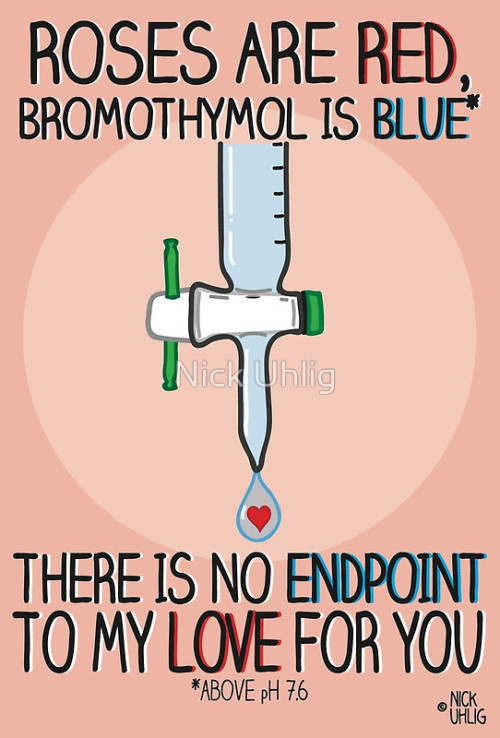
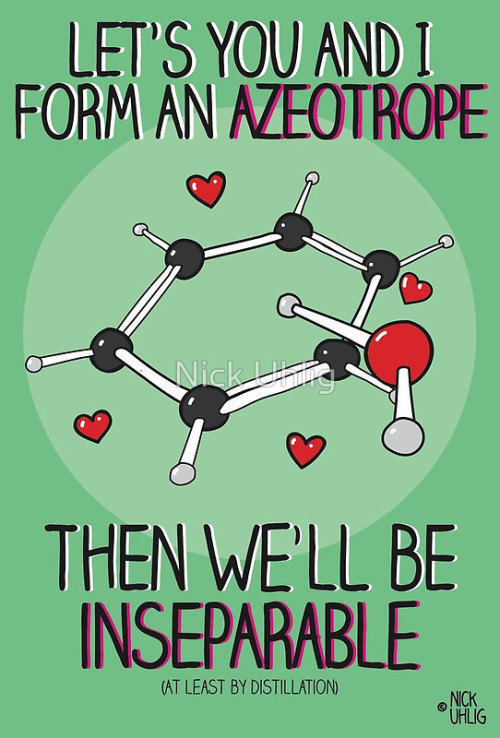
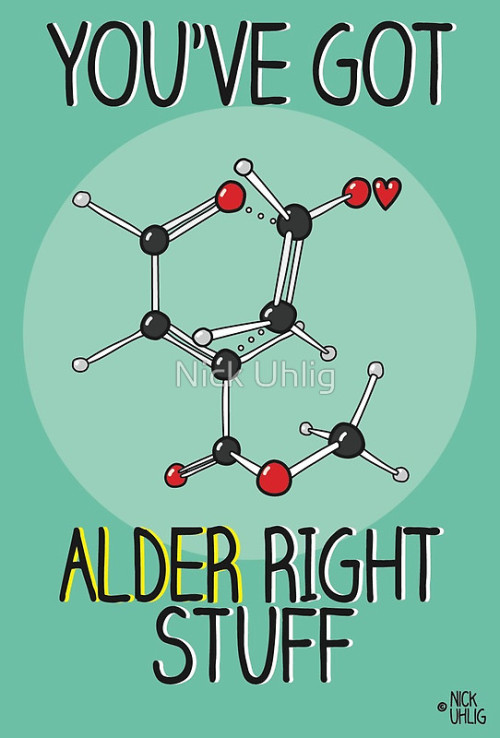

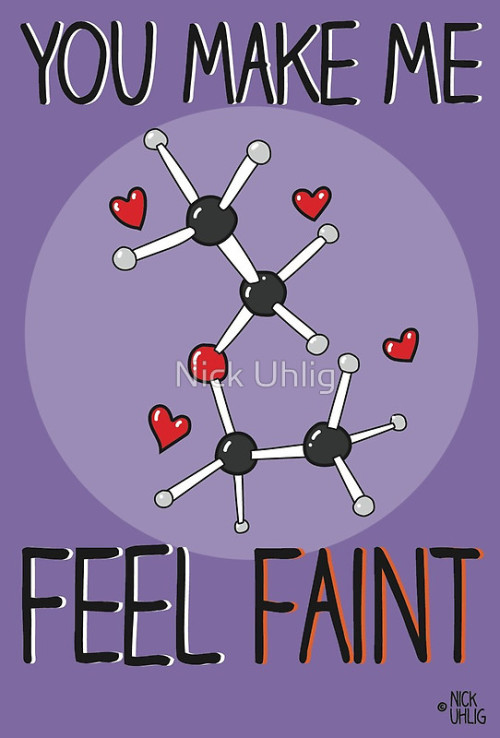

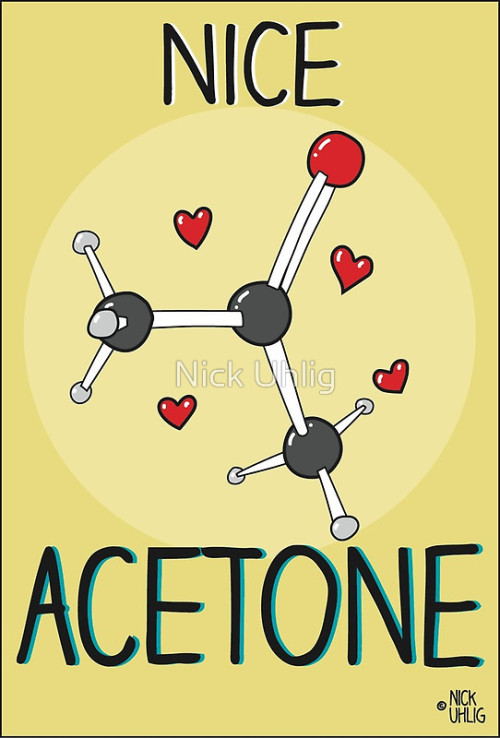
Chemistry Valentine’s Cards by Nick Uhlig.

Two years ago, a goddamn blue (yes, blue) dress got the world into a tiz over colour perception, and in November last year, it was a pair of blue and black (or are they white and gold?) Havaianas that divided families and friendships worldwide.
Now a Japanese psychologist has created another mind-warping colour illusion by swapping the red pixels for grey ones in a photo of a strawberry tart, demonstrating once again that our brains have the final say on colour.
Akiyoshi Kitaoka from Ritsumeikan University in Japan stirred up a storm recently by tweeting a filtered photo of a strawberry tart and announcing there were no red pixels in the picture, contrary to what it might look like.
Continue Reading.
You may be surprised about what you are ACTUALLY eating!
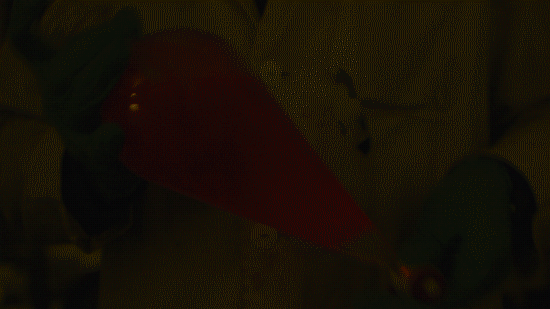
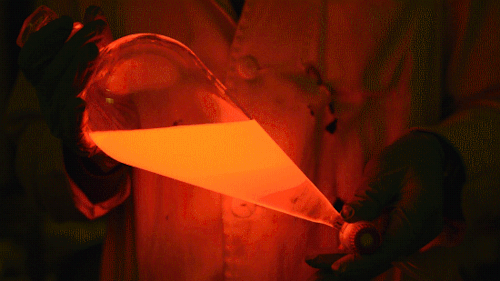
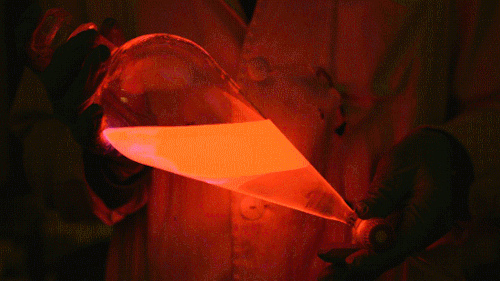
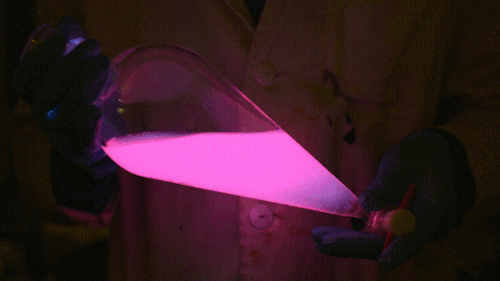
Playing with the glowstick reaction using TCPO (bis(2,4,6-trichlorophenyl) oxalate).
The glow stick contains two chemicals and a suitable dye. One of the chemicals is a diaryl oxalate (in this case TCPO, or bis(2,4,6-trichlorophenyl) oxalate), the other one is an oxidizer, usually hydrogen peroxide. By mixing the peroxide with the oxalate ester, a chemical reaction takes place, releasing energy that excites the dye, which then relaxes by releasing a photon, emitting light. The color of the emitted light depends on the structure of the dye. The chemistry behind the reaction is something like this:

During this reaction I used two type of dyes, on of them was Nile Red, what is a quite special, solvatofluorescent dye and Perylene what is a polyaromatic hydrocarbon. When used in pure form the perylene emits a bright blue light, but when its combined with Nile Red, it emits this nice pinkish-purple as seen on the gifs above and on this video:
Mammals both produce milk and have hair. Ergo, a coconut is a mammal.

Aurora - Nutirwik Creek, Brooks Range, Alaska | by Fred Wasmer
Largest Batch of Earth-size, Habitable Zone Planets
Our Spitzer Space Telescope has revealed the first known system of seven Earth-size planets around a single star. Three of these planets are firmly located in an area called the habitable zone, where liquid water is most likely to exist on a rocky planet.

This exoplanet system is called TRAPPIST-1, named for The Transiting Planets and Planetesimals Small Telescope (TRAPPIST) in Chile. In May 2016, researchers using TRAPPIST announced they had discovered three planets in the system.

Assisted by several ground-based telescopes, Spitzer confirmed the existence of two of these planets and discovered five additional ones, increasing the number of known planets in the system to seven.
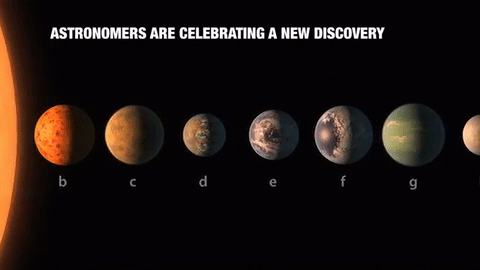
This is the FIRST time three terrestrial planets have been found in the habitable zone of a star, and this is the FIRST time we have been able to measure both the masses and the radius for habitable zone Earth-sized planets.
All of these seven planets could have liquid water, key to life as we know it, under the right atmospheric conditions, but the chances are highest with the three in the habitable zone.

At about 40 light-years (235 trillion miles) from Earth, the system of planets is relatively close to us, in the constellation Aquarius. Because they are located outside of our solar system, these planets are scientifically known as exoplanets. To clarify, exoplanets are planets outside our solar system that orbit a sun-like star.

In this animation, you can see the planets orbiting the star, with the green area representing the famous habitable zone, defined as the range of distance to the star for which an Earth-like planet is the most likely to harbor abundant liquid water on its surface. Planets e, f and g fall in the habitable zone of the star.
Using Spitzer data, the team precisely measured the sizes of the seven planets and developed first estimates of the masses of six of them. The mass of the seventh and farthest exoplanet has not yet been estimated.

For comparison…if our sun was the size of a basketball, the TRAPPIST-1 star would be the size of a golf ball.
Based on their densities, all of the TRAPPIST-1 planets are likely to be rocky. Further observations will not only help determine whether they are rich in water, but also possibly reveal whether any could have liquid water on their surfaces.
The sun at the center of this system is classified as an ultra-cool dwarf and is so cool that liquid water could survive on planets orbiting very close to it, closer than is possible on planets in our solar system. All seven of the TRAPPIST-1 planetary orbits are closer to their host star than Mercury is to our sun.

The planets also are very close to each other. How close? Well, if a person was standing on one of the planet’s surface, they could gaze up and potentially see geological features or clouds of neighboring worlds, which would sometimes appear larger than the moon in Earth’s sky.

The planets may also be tidally-locked to their star, which means the same side of the planet is always facing the star, therefore each side is either perpetual day or night. This could mean they have weather patterns totally unlike those on Earth, such as strong wind blowing from the day side to the night side, and extreme temperature changes.

Because most TRAPPIST-1 planets are likely to be rocky, and they are very close to one another, scientists view the Galilean moons of Jupiter – lo, Europa, Callisto, Ganymede – as good comparisons in our solar system. All of these moons are also tidally locked to Jupiter. The TRAPPIST-1 star is only slightly wider than Jupiter, yet much warmer.
How Did the Spitzer Space Telescope Detect this System?
Spitzer, an infrared telescope that trails Earth as it orbits the sun, was well-suited for studying TRAPPIST-1 because the star glows brightest in infrared light, whose wavelengths are longer than the eye can see. Spitzer is uniquely positioned in its orbit to observe enough crossing (aka transits) of the planets in front of the host star to reveal the complex architecture of the system.

Every time a planet passes by, or transits, a star, it blocks out some light. Spitzer measured the dips in light and based on how big the dip, you can determine the size of the planet. The timing of the transits tells you how long it takes for the planet to orbit the star.

The TRAPPIST-1 system provides one of the best opportunities in the next decade to study the atmospheres around Earth-size planets. Spitzer, Hubble and Kepler will help astronomers plan for follow-up studies using our upcoming James Webb Space Telescope, launching in 2018. With much greater sensitivity, Webb will be able to detect the chemical fingerprints of water, methane, oxygen, ozone and other components of a planet’s atmosphere.
At 40 light-years away, humans won’t be visiting this system in person anytime soon…that said…this poster can help us imagine what it would be like:

Make sure to follow us on Tumblr for your regular dose of space: http://nasa.tumblr.com
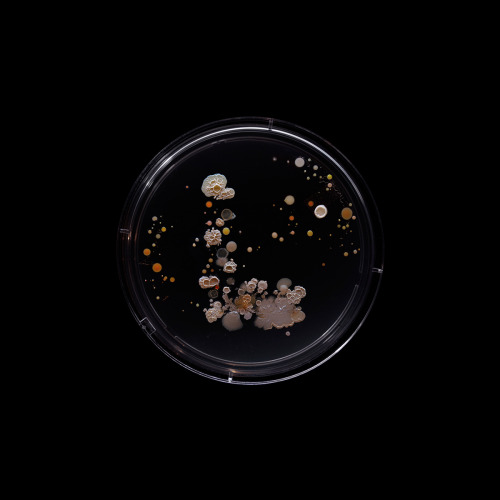
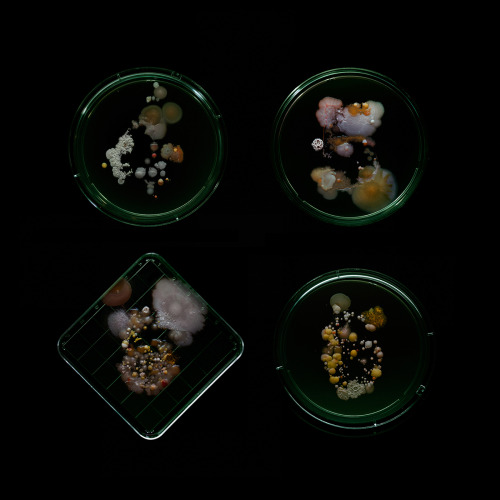
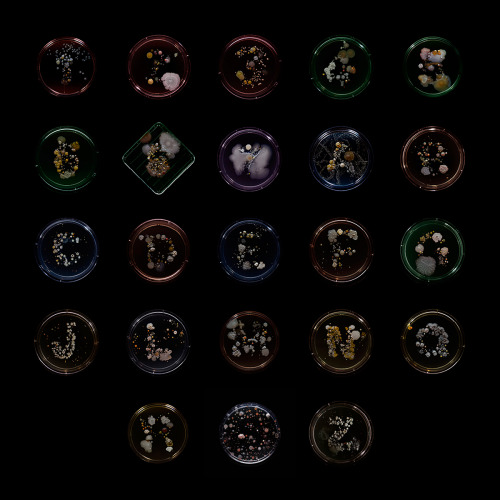
Subvisual Subway - Bacteria of the New York City subway- Craig Ward
Why Sequencing DNA in Space is a Big Deal
… And How You Can Talk to the Scientists Who Made It Happen

Less than one month ago, DNA had never been sequenced in space. As of today, more than one billion base pairs of DNA have been sequenced aboard the International Space Station, Earth’s only orbiting laboratory. The ability to sequence the DNA of living organisms in space opens a whole new world of scientific and medical possibilities. Scientists consider it a game changer.

NASA astronaut Kate Rubins, who has a background in genomics, conducted the sequencing on the space station as part of the Biomolecule Sequencer investigation. A small, commercial, off-the-shelf device called MinION (min-EYE-ON), manufactured by Oxford Nanopore Technologies in the UK, was used to sequence the DNA of bacteria, a virus and rodents. Human DNA was not sequenced, and there are no immediate plans to sequence human DNA in space.

(Image Credit: Oxford Nanopore Technologies)
The MinION is about the size of a candy bar, and plugs into a laptop or tablet via USB connection, which also provides power to the device. The tiny, plug and play sequencer is diminutive compared to the large microwave-sized sequencers used on Earth, and uses much less power. Unlike other terrestrial instruments whose sequencing run times can take days, this device’s data is available in near real time; analysis can begin within 10-15 minutes from the application of the sample.

Having real-time analysis capabilities aboard the space station could allow crews to identify microbes, diagnose infectious disease and collect genomic and genetic data concerning crew health, without having to wait long periods of time to return samples to Earth and await ground-based analysis.
The first DNA sequencing was conducted on Aug. 26, and on Sept. 14, Rubins and the team of scientists back at NASA’s Johnson Space Center in Houston hit the one-billionth-base-pairs-of-DNA-sequenced mark.

Have more questions about how the Biomolecule Sequencer works, or how it could benefit Earth or further space exploration? Ask the team of scientists behind the investigation, who will be available for questions during a Reddit Ask Me Anything on /r/science on Wednesday, Sept. 29 at 2 p.m. EDT.
The participants are:
Dr. Aaron Burton, NASA Johnson Space Center, Planetary Scientist and Principal Investigator
Dr. Sarah Castro-Wallace, NASA Johnson Space Center, Microbiologist and Project Manager
Dr. David J. Smith, NASA Ames Research Center, Microbiologist
Dr. Mark Lupisella, NASA Goddard Space Flight Center, Systems Engineer
Dr. Jason P. Dworkin, NASA Goddard Space Flight Center, Astrobiologist
Dr. Christopher E. Mason, Weill Cornell Medicine Dept. of Physiology and Biophysics, Associate Professor
A scientific parody of Do you wanna build a snowman? from Disney’s Frozen. Lyrics by hyacynthus and myself. Vocals by me. A music video may be forthcoming.
-
 n-hetrocyclic3765 reblogged this · 2 years ago
n-hetrocyclic3765 reblogged this · 2 years ago -
 n-hetrocyclic3765 liked this · 2 years ago
n-hetrocyclic3765 liked this · 2 years ago -
 amightydirge liked this · 6 years ago
amightydirge liked this · 6 years ago -
 arktouros reblogged this · 6 years ago
arktouros reblogged this · 6 years ago -
 arktouros liked this · 6 years ago
arktouros liked this · 6 years ago -
 optimisticmiraclellama-blog reblogged this · 7 years ago
optimisticmiraclellama-blog reblogged this · 7 years ago -
 chlorinemaze-blog liked this · 8 years ago
chlorinemaze-blog liked this · 8 years ago -
 day-dreamer01 reblogged this · 8 years ago
day-dreamer01 reblogged this · 8 years ago -
 day-dreamer01 liked this · 8 years ago
day-dreamer01 liked this · 8 years ago -
 creationmax76 liked this · 8 years ago
creationmax76 liked this · 8 years ago -
 wingedelmworld reblogged this · 9 years ago
wingedelmworld reblogged this · 9 years ago -
 wingedelmworld liked this · 9 years ago
wingedelmworld liked this · 9 years ago -
 abbygine-blog reblogged this · 9 years ago
abbygine-blog reblogged this · 9 years ago -
 abbygine-blog liked this · 9 years ago
abbygine-blog liked this · 9 years ago -
 chellaon reblogged this · 9 years ago
chellaon reblogged this · 9 years ago -
 trevors-vampire-wifey reblogged this · 9 years ago
trevors-vampire-wifey reblogged this · 9 years ago -
 thisisacatperson reblogged this · 9 years ago
thisisacatperson reblogged this · 9 years ago -
 equinox-threshold reblogged this · 9 years ago
equinox-threshold reblogged this · 9 years ago -
 justatouchofsomething reblogged this · 9 years ago
justatouchofsomething reblogged this · 9 years ago -
 thecuriousmach reblogged this · 9 years ago
thecuriousmach reblogged this · 9 years ago -
 technicolorllamas liked this · 10 years ago
technicolorllamas liked this · 10 years ago -
 lorenzens-soil reblogged this · 10 years ago
lorenzens-soil reblogged this · 10 years ago -
 lorenzens-soil liked this · 10 years ago
lorenzens-soil liked this · 10 years ago -
 xx-smile-infusion-xx reblogged this · 10 years ago
xx-smile-infusion-xx reblogged this · 10 years ago -
 violavera liked this · 10 years ago
violavera liked this · 10 years ago -
 sisixd liked this · 10 years ago
sisixd liked this · 10 years ago -
 yellowbaobao liked this · 10 years ago
yellowbaobao liked this · 10 years ago -
 facultyloungecosplay reblogged this · 10 years ago
facultyloungecosplay reblogged this · 10 years ago -
 k0bster reblogged this · 10 years ago
k0bster reblogged this · 10 years ago -
 dralivis liked this · 10 years ago
dralivis liked this · 10 years ago -
 thatcomicbookgirl reblogged this · 10 years ago
thatcomicbookgirl reblogged this · 10 years ago -
 lament-of-ajna liked this · 10 years ago
lament-of-ajna liked this · 10 years ago -
 fucked-as-deserved liked this · 10 years ago
fucked-as-deserved liked this · 10 years ago -
 lav3nd3rm3nac3 liked this · 10 years ago
lav3nd3rm3nac3 liked this · 10 years ago -
 hehe---xd reblogged this · 10 years ago
hehe---xd reblogged this · 10 years ago -
 distantbeliefs reblogged this · 10 years ago
distantbeliefs reblogged this · 10 years ago
60 posts